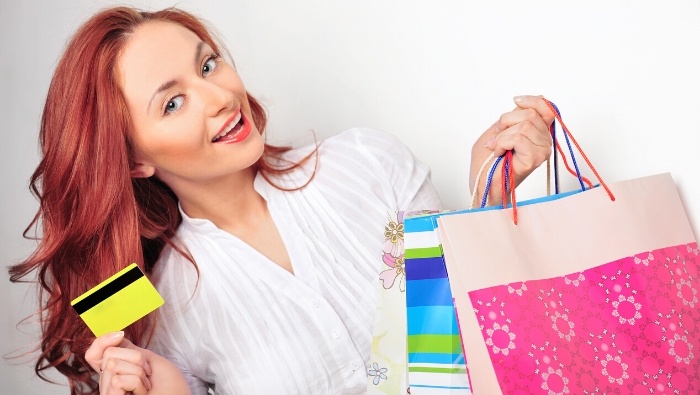Why We Spend More Using Credit Cards

There’s a reason stores don’t want you to use cash. Did you know people tend to spend more when paying with plastic? Read on to find out why and what you can do to keep your spending in check when using your credit card.
If you are worried about coming up with the money to pay for your credit card bill next month or are ignoring the calls from creditors, guess what? You’re not alone.
According to LendingTree, in the third quarter of 2022, Americans carried a balance on 43.4% of all active credit cards. But why? What is it about that plastic card that makes us swipe so often without hesitation?
Economists have been researching this exact question for years, and what they have found reveals more about our human psyche than about credit cards.
Some of us spend up to 100% more when paying with a credit card instead of cash
MIT Professors Drazen Prelec and Duncan Simester conducted a study that revealed that people who used credit cards were not only more willing to spend money, but spent more money than they would if they carried cash only. They found that some shoppers spent up to 100% more when using their credit card to pay instead of cash.
In one of their studies of a group of MBA students, Prelec and Simester offered participants the opportunity to buy basketball tickets to a desirable game. Those told they could pay with a credit card were willing to pay twice as much as those who had to pay in cash.
Another group of MBA students was willing to pay almost twice as much for an item that had an unknown market value (a pair of Red Sox tickets) when they could pay with a credit card compared to when they could pay with cash.
Related: The Emotions Behind Buying Stuff
Sign Up for Savings
Subscribe to get money-saving content by email that can help you stretch your dollars further.
Twice each week, you'll receive articles and tips that can help you free up and keep more of your hard-earned money, even on the tightest of budgets.
We respect your privacy. Unsubscribe at any time.
What is ‘coupling’ and how does it make us more willing to spend…or not?
When we make a purchase there is a phenomenon called “coupling” that comes into play that affects whether we are willing to pay for an item, and how much we are willing to spend. Coupling, a term coined by Drazen Prelec and economist George Loewenstein of Mellon University, is a term that describes the psychological link of the buyer between the consumption experience and the payment for that experience.
With every purchase we make, a connection or coupling exists in our psyche. When we pay in cash, the connection between the two are apparent, and therefore painful.
For example, if I pay for a sandwich with cash, I know immediately how much the sandwich will be and how much I must spend on it. It is obvious how much I am giving away for what I want, which results in some amount of pain for most of us. However, if I pay with a credit card, the coupling is not as obvious, and therefore less painful. As a result, I spend more and more money without the pain or the realization.
Credit cards not only reduce the sting of payment, but there is some evidence that they also stimulate desire.
In a series of experiments in the 1980s, Richard Feinberg manipulated whether or not credit card logos were visible while participants contemplated how much they would be willing to pay in cash for several products. People who used a credit card in contrast to those who used cash experienced a stimulus to buy more. Feinberg found that willingness to pay and actual cash donations to charity were significantly greater when credit card logos were visible than when they were not.
The results suggest that consumers have been conditioned to associate credit card logos with consumption. Therefore, exposure to credit card logos may stimulate a sort of craving, much like smelling fresh cookies stimulates hunger.
How can we prevent credit card overspending and debt?
From what we know through years of research of the psychology behind using credit cards, how can we overcome the debt that is associated with it?
One tip is to avoid having a credit card in the first place. Entrepreneur Mark Cuban suggests using a debit card. A perfect card to use is a reloadable debit card. With a debit card, you have to use your own money to reload the card instead of borrowing from someone else when using a credit card. This keeps you accountable and creates the sting of coupling since it is your money.
However, if you can’t imagine getting rid of your credit cards, another way to avoid debt is to write down how much you spend using your credit card every time you make a purchase. This keeps you more aware of how much money you are spending, which causes the same psychological triggers and pain as you experience when paying with cash.
Have you overspent your way into debt?
Make a plan to get back out. Get How to Conquer Your Debt No Matter How Much You Have and create a debt payoff plan personalized to your budget and lifestyle.
Reviewed June 2023
Sign Up for Savings
Subscribe to get money-saving content by email that can help you stretch your dollars further.
Twice each week, you'll receive articles and tips that can help you free up and keep more of your hard-earned money, even on the tightest of budgets.
We respect your privacy. Unsubscribe at any time.
Wouldn't you like to be a Stretcher too?
Subscribe to get our money-saving content twice per week by email and start living better for less.
We respect your privacy. Unsubscribe at any time.

